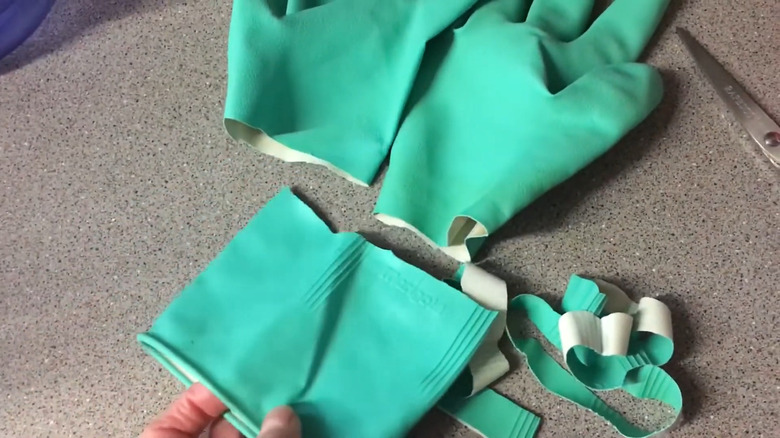Don't Throw Out Rubber Gloves - Cut And Use As Waterproof Plant Ties
Some things, like the cardboard box your online purchase arrived in, are both obviously recyclable and easy to dispose of mindfully. Others, not so much. Take rubber gloves, for example. They're not biodegradable, and while they can be recycled in theory, the process isn't exactly simple — curbside programs won't always accept them, and specialized drop-off points are few and far between. So, instead of letting them pile up in a landfill, a much better solution is to cut the gloves up and use them as DIY plant ties.
Rubber gloves — especially the kind you use in the kitchen — are surprisingly durable and flexible, even after a bit of wear. Most of the time, the only reason you stop using them is because of a small cut or tear. This makes them useless for washing dishes, but perfect for upcycling. With just a few snips, they can be transformed into weather-resistant, plant-friendly ties for your garden. Unlike zip ties or rough twine, they won't dig into delicate stems or degrade in the rain. And since you're repurposing something you already have, you're saving money and cutting down on waste at the same time. It's a simple, satisfying project that takes seconds and gives new life to something that would probably have ended up in the trash. If you're already repurposing yogurt tubs or putting egg cartons in your planters, this clever trick will feel right on par with your sustainability-first routine.
How to create plant ties from your old rubber gloves
The first step is to clean and dry the gloves thoroughly, as any leftover dish detergent residue could potentially irritate or harm your plants. Next, using a sharp pair of craft or kitchen scissors, cut off the cuff portion of the glove (this is the thicker, rolled area near the wrist). From there, continue cutting across the width of the cuff to create rubber rings or bands. How thick you cut them will depend on how sturdy or stretchy you want your ties to be. These looped bands can then be used as is or snipped open if you need longer lengths. You can also cut the fingers up for smaller elastic bands. (Alternatively, keep them whole and use them for DIY projects where you need to spread glue or sealant.)
When it comes time to use them in the garden, just loop a strip around the plant stem and whatever support you're using, and tie it gently. Because the rubber has a bit of give, it allows the plant to sway naturally in the wind without digging into the stem or causing damage, which is a common problem with wire or twine. They're especially helpful for young trees, fast-growing plants that need regular adjusting, or for supporting your tomato plants. And since you're cutting the ties yourself, you can easily size them to fit whatever you're working with — no waste, no fuss. If you're someone who always wear rubber gloves when cleaning, this is a great way to extend their usefulness while doing the environment a favor in the process.

